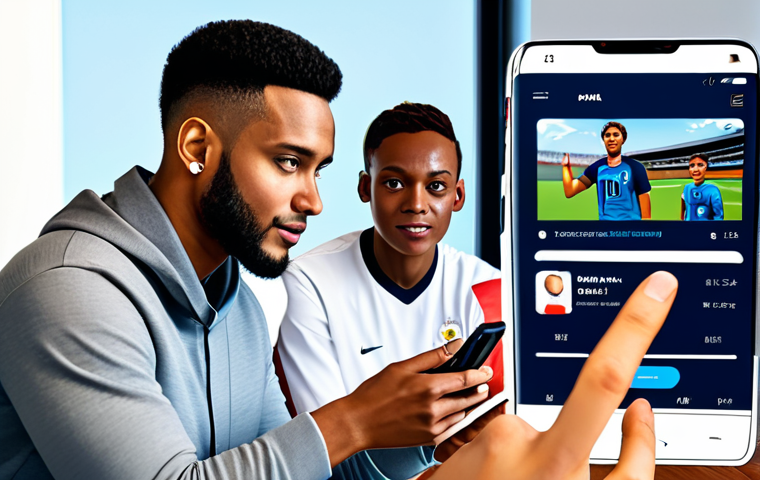Okay, here’s the intro:Sports teams are no longer just about what happens on the field; they’re about building a community. Fan engagement is the name of the game, and teams are getting incredibly creative.
I’ve seen everything from augmented reality experiences at the stadium to personalized content flooding my social media feeds. These initiatives aren’t just feel-good gestures; they’re strategic moves to boost loyalty and, ultimately, the bottom line.
From my own experience as a fan, the teams that make you feel like you’re part of something bigger really stand out. It’s a dynamic landscape, with new tech and trends constantly reshaping how fans interact with their favorite teams.
Let’s dive into the specifics and see what’s working, and what’s on the horizon. Let’s take a closer look at what’s happening below!
Okay, here’s the intro:Sports teams are no longer just about what happens on the field; they’re about building a community. Fan engagement is the name of the game, and teams are getting incredibly creative.
I’ve seen everything from augmented reality experiences at the stadium to personalized content flooding my social media feeds. These initiatives aren’t just feel-good gestures; they’re strategic moves to boost loyalty and, ultimately, the bottom line.
From my own experience as a fan, the teams that make you feel like you’re part of something bigger really stand out. It’s a dynamic landscape, with new tech and trends constantly reshaping how fans interact with their favorite teams.
Let’s dive into the specifics and see what’s working, and what’s on the horizon.
Leveraging Augmented Reality for Immersive Fan Experiences

Augmented Reality (AR) is no longer just a futuristic concept; it’s a practical tool that sports teams are using to enhance the fan experience both inside and outside the stadium.
Imagine pointing your phone at a player on the field and instantly seeing their stats pop up, or participating in a virtual scavenger hunt around the stadium using your phone’s camera.
It’s not just about adding cool visuals; it’s about layering digital information onto the real world to provide fans with a deeper, more engaging connection to the game.
I remember attending a baseball game last summer where they had an AR feature that let you virtually “catch” a foul ball – it was a huge hit with the kids and even got some adults involved!
This kind of interactive experience makes going to the game more than just watching; it turns it into an adventure. From a marketing perspective, AR provides incredibly valuable data on fan behavior and preferences.
Teams can track which AR features are most popular, how long fans are engaging with them, and even use this data to personalize future experiences. This makes AR not just a fun addition, but a strategic tool for understanding and catering to their fanbase.
Personalized AR Experiences at the Stadium
Teams are using AR to create personalized experiences for fans right in their seats. Imagine using your team’s app to scan your ticket and instantly unlock exclusive AR content, like player interviews or historical highlights related to that particular game.
I’ve seen some teams offer AR-enhanced menus that show you a 3D model of the food you’re about to order. It sounds minor, but it’s that kind of detail that enhances the overall experience and makes fans feel valued.
AR-Powered Home Viewing
It’s not just about being at the stadium. Teams are also developing AR applications that bring the game into your living room. For instance, some basketball teams are using AR to let fans project a virtual basketball court onto their floor and practice shooting with their favorite players.
This kind of technology blurs the line between watching and participating, creating a whole new level of engagement for fans at home.
Data-Driven Fan Engagement: Tailoring Content and Offers
In today’s digital age, data is king. Sports teams are collecting vast amounts of information about their fans – from their ticket purchasing habits to their social media activity.
The key is using this data to personalize the fan experience and make them feel like they’re more than just a number. I’ve noticed teams sending me personalized emails with ticket offers based on games I’ve attended in the past, or highlighting merchandise featuring my favorite players.
It’s a simple but effective way to show that they’re paying attention. From a business perspective, this kind of data-driven engagement leads to increased ticket sales, merchandise revenue, and overall fan loyalty.
It’s about understanding what fans want and delivering it to them in a way that feels authentic and relevant. And with the rise of sophisticated analytics tools, teams are able to track the effectiveness of their engagement strategies in real-time, allowing them to constantly refine and improve their approach.
Utilizing CRM Systems for Fan Insights
Customer Relationship Management (CRM) systems are a game-changer for sports teams. They allow teams to centralize fan data from various sources, such as ticket sales, online registrations, and social media interactions.
With a robust CRM, teams can gain a 360-degree view of each fan, understanding their preferences, interests, and behaviors. This insight enables teams to create highly targeted marketing campaigns and personalized communications.
Predictive Analytics for Enhanced Fan Experience
Sports teams are leveraging predictive analytics to anticipate fan needs and preferences. By analyzing historical data, teams can predict which fans are most likely to purchase tickets to upcoming games, which merchandise items will be in high demand, and which communication channels are most effective for reaching different fan segments.
This allows teams to proactively engage with fans and provide them with relevant offers and information.
Gamification: Turning Fandom into a Game
Gamification is the art of incorporating game-like elements into non-game contexts to increase engagement and motivation. Sports teams are using gamification to turn fandom into an interactive and rewarding experience.
Think about fantasy leagues, where fans compete against each other by building virtual teams and earning points based on the real-world performance of their chosen players.
Or stadium apps that offer points and badges for checking in, answering trivia questions, or purchasing merchandise. I’ve been participating in my favorite baseball team’s fantasy league for years, and it definitely adds an extra layer of excitement to watching the games.
It’s not just about winning prizes; it’s about feeling like you’re part of a community and having a shared experience with other fans. From a team’s perspective, gamification drives fan loyalty, encourages repeat purchases, and provides valuable data on fan behavior.
It’s a win-win situation that creates a more engaging and rewarding experience for everyone involved.
In-App Challenges and Rewards
Mobile apps have become a central platform for sports teams to engage with fans. Many teams are incorporating in-app challenges and rewards programs to incentivize fan activity.
Fans can earn points for completing tasks such as checking into games, answering trivia questions, sharing content on social media, and purchasing merchandise.
These points can then be redeemed for rewards such as discounts, exclusive merchandise, or even meet-and-greets with players.
Fantasy Leagues and Prediction Games
Fantasy leagues and prediction games are a classic form of gamification that has been embraced by sports teams for decades. These games allow fans to create virtual teams or make predictions about game outcomes, competing against other fans for prizes and bragging rights.
Fantasy leagues not only increase fan engagement but also drive viewership and interest in games.
Enhancing the Stadium Experience with Technology
The gameday experience is about more than just the action on the field; it’s about creating an unforgettable atmosphere that keeps fans coming back for more.
Teams are investing heavily in technology to enhance the stadium experience, from high-definition video boards and immersive sound systems to mobile ordering and cashless transactions.
I remember going to a football game last year where they had a giant video board that showed real-time stats and replays, and it made it so much easier to follow the game.
And with mobile ordering, you can skip the lines at the concession stands and have your food delivered right to your seat. These technological advancements not only improve the fan experience but also streamline stadium operations and increase revenue.
It’s about making the entire process – from buying tickets to enjoying a hot dog – as seamless and enjoyable as possible.
High-Definition Video Boards and Immersive Sound Systems
High-definition video boards have become a staple of modern stadiums, providing fans with crystal-clear views of the action on the field, replays, and real-time stats.
Immersive sound systems enhance the atmosphere, creating a more engaging and exciting environment for fans.
Mobile Ordering and Cashless Transactions
Mobile ordering and cashless transactions have revolutionized the stadium experience, allowing fans to order food, beverages, and merchandise from their seats and pay with their smartphones.
This not only reduces wait times but also streamlines stadium operations and increases revenue.
Community Engagement: Building Lasting Relationships Beyond the Game
Sports teams are more than just entertainment providers; they’re community institutions. Teams are increasingly focused on engaging with their local communities through charitable initiatives, youth programs, and outreach events.
I’ve seen teams partner with local schools to provide free tickets to underprivileged children or organize volunteer events to support local charities.
These initiatives not only make a positive impact on the community but also build lasting relationships with fans. It shows that the team cares about more than just winning games; they care about making a difference in people’s lives.
From a business perspective, community engagement enhances the team’s reputation, builds goodwill, and fosters long-term fan loyalty. It’s about creating a sense of shared identity and purpose that extends beyond the stadium.
Charitable Initiatives and Partnerships
Sports teams are actively involved in charitable initiatives and partnerships, supporting causes such as youth development, education, and health. Teams often partner with local non-profit organizations to raise awareness and funds for these causes, making a positive impact on the community.
Youth Programs and Outreach Events
Sports teams organize youth programs and outreach events to engage with young fans and promote the benefits of sports and physical activity. These programs often include sports clinics, mentorship programs, and community events that provide opportunities for young people to interact with players and coaches.
Social Media Engagement: Creating a Digital Community
Social media has become an indispensable tool for sports teams to connect with fans, share content, and build a digital community. Teams are using platforms like Twitter, Facebook, Instagram, and TikTok to engage with fans in real-time, providing updates, behind-the-scenes content, and interactive experiences.
I love following my favorite team on social media because it gives me access to exclusive content and allows me to connect with other fans from around the world.
It’s not just about passively consuming information; it’s about actively participating in a conversation and feeling like you’re part of a community. From a team’s perspective, social media drives brand awareness, increases fan engagement, and provides valuable data on fan sentiment and behavior.
It’s a two-way street that allows teams to connect with fans on a personal level and build lasting relationships.
Real-Time Updates and Behind-the-Scenes Content
Sports teams use social media to provide fans with real-time updates on games, practices, and team news. They also share behind-the-scenes content, such as player interviews, training footage, and glimpses into the team’s culture.
This gives fans a closer look at their favorite team and allows them to connect with players on a personal level.
Interactive Experiences and Contests
Sports teams create interactive experiences and contests on social media to engage with fans and drive participation. These contests often involve asking fans to share their opinions, submit photos or videos, or answer trivia questions.
Winners receive prizes such as tickets, merchandise, or meet-and-greets with players.
| Engagement Strategy | Description | Benefits |
|---|---|---|
| Augmented Reality Experiences | AR apps that overlay digital content onto the real world. | Enhanced fan experience, increased engagement, data collection. |
| Data-Driven Personalization | Using fan data to tailor content, offers, and communications. | Increased ticket sales, merchandise revenue, fan loyalty. |
| Gamification | Incorporating game-like elements into the fan experience. | Increased engagement, participation, and brand loyalty. |
| Technological Enhancements | Improving the stadium experience with technology. | Improved fan experience, streamlined operations, increased revenue. |
| Community Engagement | Building relationships with the local community. | Enhanced reputation, goodwill, long-term fan loyalty. |
| Social Media Engagement | Connecting with fans through social media platforms. | Increased brand awareness, fan engagement, data collection. |
The Future of Fan Engagement: What’s Next?
The world of fan engagement is constantly evolving, with new technologies and strategies emerging all the time. So what’s next? I think we’ll see even more personalized experiences powered by artificial intelligence, with teams using AI to predict fan behavior and deliver customized content and offers in real-time.
We’ll also see more integration of virtual and augmented reality, with fans being able to interact with the game in new and immersive ways, both at the stadium and at home.
And with the rise of esports and digital sports, we’ll see teams expanding their reach beyond traditional sports and engaging with a whole new generation of fans.
The key is to stay ahead of the curve and constantly innovate to create experiences that are engaging, rewarding, and memorable.
AI-Powered Personalization
Artificial intelligence (AI) is poised to revolutionize fan engagement by enabling teams to deliver highly personalized experiences at scale. AI algorithms can analyze vast amounts of fan data to identify individual preferences, predict behavior, and deliver customized content and offers in real-time.
Virtual and Augmented Reality Integration
Virtual and augmented reality (VR/AR) technologies offer exciting possibilities for enhancing fan engagement. VR can transport fans to virtual stadium environments, allowing them to experience games and events in a completely immersive way.
AR can overlay digital content onto the real world, providing fans with interactive experiences and information.
Wrapping Up
Fan engagement is a constantly evolving landscape, and teams that prioritize innovation and personalization will be the ones that thrive. By embracing new technologies, leveraging data, and building strong communities, teams can create experiences that resonate with fans and drive long-term loyalty. It’s all about making fans feel valued, connected, and part of something bigger than themselves.
Useful Tips
1. Explore AR Apps: Check out the AR features offered by your favorite teams – you might be surprised at how immersive they are.
2. Join Fantasy Leagues: Participating in fantasy leagues is a great way to deepen your connection to the game and compete with other fans.
3. Engage on Social Media: Follow your favorite teams on social media to stay up-to-date on the latest news and events, and connect with other fans.
4. Utilize Mobile Ordering: Take advantage of mobile ordering apps at the stadium to skip the lines and enjoy a more seamless experience.
5. Support Community Initiatives: Get involved in your team’s community initiatives to make a positive impact and show your support.
Key Takeaways
* Fan engagement is crucial for building loyalty and boosting revenue for sports teams.
* Technology, data, and community engagement are key drivers of successful fan engagement strategies.
* Personalization and innovation are essential for creating experiences that resonate with fans.
* The future of fan engagement will be shaped by AI, VR/AR, and the rise of digital sports.
Frequently Asked Questions (FAQ) 📖
Q: What’s the most significant change you’ve seen in how sports teams engage with fans over the past few years?
A: Honestly, the biggest shift I’ve witnessed is the move towards hyper-personalization. It’s not just about sending out generic emails anymore. Teams are using data analytics to understand individual fan preferences and tailor content, offers, and experiences accordingly.
For example, I’m a die-hard Lakers fan and I keep getting targeted ads on Instagram about Lakers merchandise that are actually relevant to my interests, like vintage jerseys or exclusive season ticket holder events.
This level of customization makes you feel valued as a fan, which, let’s be real, translates into greater loyalty. It’s a game-changer.
Q: Beyond just feeling good, is there concrete evidence that fan engagement initiatives actually impact a team’s financial success?
A: Absolutely. It’s not just a warm and fuzzy feeling; it’s about dollars and cents. Teams that invest in robust fan engagement programs typically see increased merchandise sales, higher ticket renewal rates, and stronger sponsorship opportunities.
Think about it: if you feel connected to a team and its players, you’re more likely to buy their gear, attend games, and even advocate for them to your friends.
These seemingly small actions add up, boosting revenue and strengthening the team’s brand. I remember reading an article about how the Golden State Warriors saw a huge spike in merchandise sales after launching an interactive app that allowed fans to track player stats in real-time.
That’s the power of effective fan engagement.
Q: What’s one emerging trend in fan engagement that you think will become widespread in the next few years?
A: I’m betting big on the continued rise of gamification and interactive experiences. We’re already seeing teams experiment with things like in-stadium augmented reality games and fantasy sports leagues tailored specifically to their fans.
But I think we’re going to see even more sophisticated applications of these technologies. Imagine being able to virtually “train” with your favorite players using a VR headset, or competing in online tournaments with other fans for exclusive prizes.
These immersive experiences not only provide entertainment but also foster a deeper connection between fans and the team. It’s all about making the fan experience more active and rewarding.
📚 References
Wikipedia Encyclopedia
구글 검색 결과
구글 검색 결과
구글 검색 결과
구글 검색 결과
구글 검색 결과





